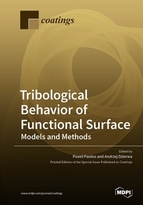Tribological Behavior of Functional Surface: Models and Methods
A special issue of Coatings (ISSN 2079-6412). This special issue belongs to the section "Corrosion, Wear and Erosion".
Deadline for manuscript submissions: closed (31 December 2020) | Viewed by 36238
Special Issue Editors
Interests: surface engineering; tribology; friction; wear; lubrication; contact mechanics
Special Issues, Collections and Topics in MDPI journals
Interests: tribology; friction; wear; surface engineering; surface metrology; manufacturing processes
Special Issues, Collections and Topics in MDPI journals
Special Issue Information
Dear Colleagues,
It is our pleasure to invite you to submit a manuscript to the forthcoming Special Issue “Tribological Behavior of Functional Surfaces: Models and Experiments” in Coatings (Open Access Materials Science Journal; Impact Factor 2.33).
Surfaces of solid bodies contain characteristic features, affecting the functional properties of machine elements. Surface topography restricting the contact area to a very small ratio of the nominal area is one of the fundamental features of significant importance for contact mechanics, friction wear, and lubrication. Surface engineering improves tribological performance. Surface texturing is a method used in surface engineering to improve the sliding properties of assemblies by creating dimples on surfaces. Tribological processes can lead to increased chemical reactivity. Understanding of surface processes at the nanoscale is very important.
The aim of this Special Issue is to collect high-quality research papers, short communications, and review articles that focus on the tribological behavior of functional surfaces. Contributions involving modeling and/or experimental approaches are particularly welcome.
Should you need any further information about this Special Issue, please do not hesitate to contact us.
Prof. Dr. Pawel Pawlus
Dr. Andrzej Dzierwa
Guest Editors
Manuscript Submission Information
Manuscripts should be submitted online at www.mdpi.com by registering and logging in to this website. Once you are registered, click here to go to the submission form. Manuscripts can be submitted until the deadline. All submissions that pass pre-check are peer-reviewed. Accepted papers will be published continuously in the journal (as soon as accepted) and will be listed together on the special issue website. Research articles, review articles as well as short communications are invited. For planned papers, a title and short abstract (about 100 words) can be sent to the Editorial Office for announcement on this website.
Submitted manuscripts should not have been published previously, nor be under consideration for publication elsewhere (except conference proceedings papers). All manuscripts are thoroughly refereed through a single-blind peer-review process. A guide for authors and other relevant information for submission of manuscripts is available on the Instructions for Authors page. Coatings is an international peer-reviewed open access monthly journal published by MDPI.
Please visit the Instructions for Authors page before submitting a manuscript. The Article Processing Charge (APC) for publication in this open access journal is 2600 CHF (Swiss Francs). Submitted papers should be well formatted and use good English. Authors may use MDPI's English editing service prior to publication or during author revisions.
Keywords
- Tribology
- Contact mechanics
- Surface engineering
- Surface texturing
- Surface chemistry
- Nanoscale tribology







